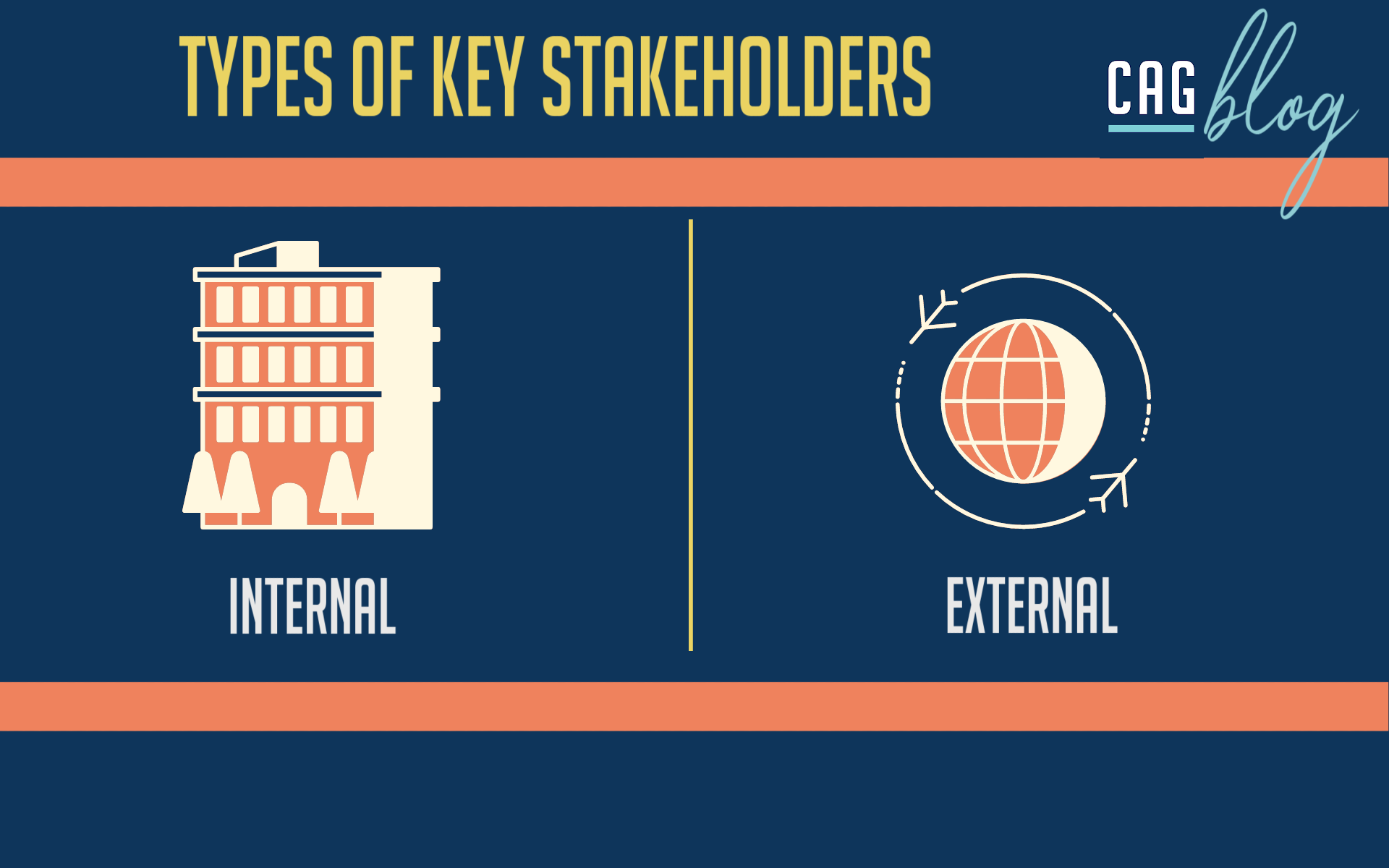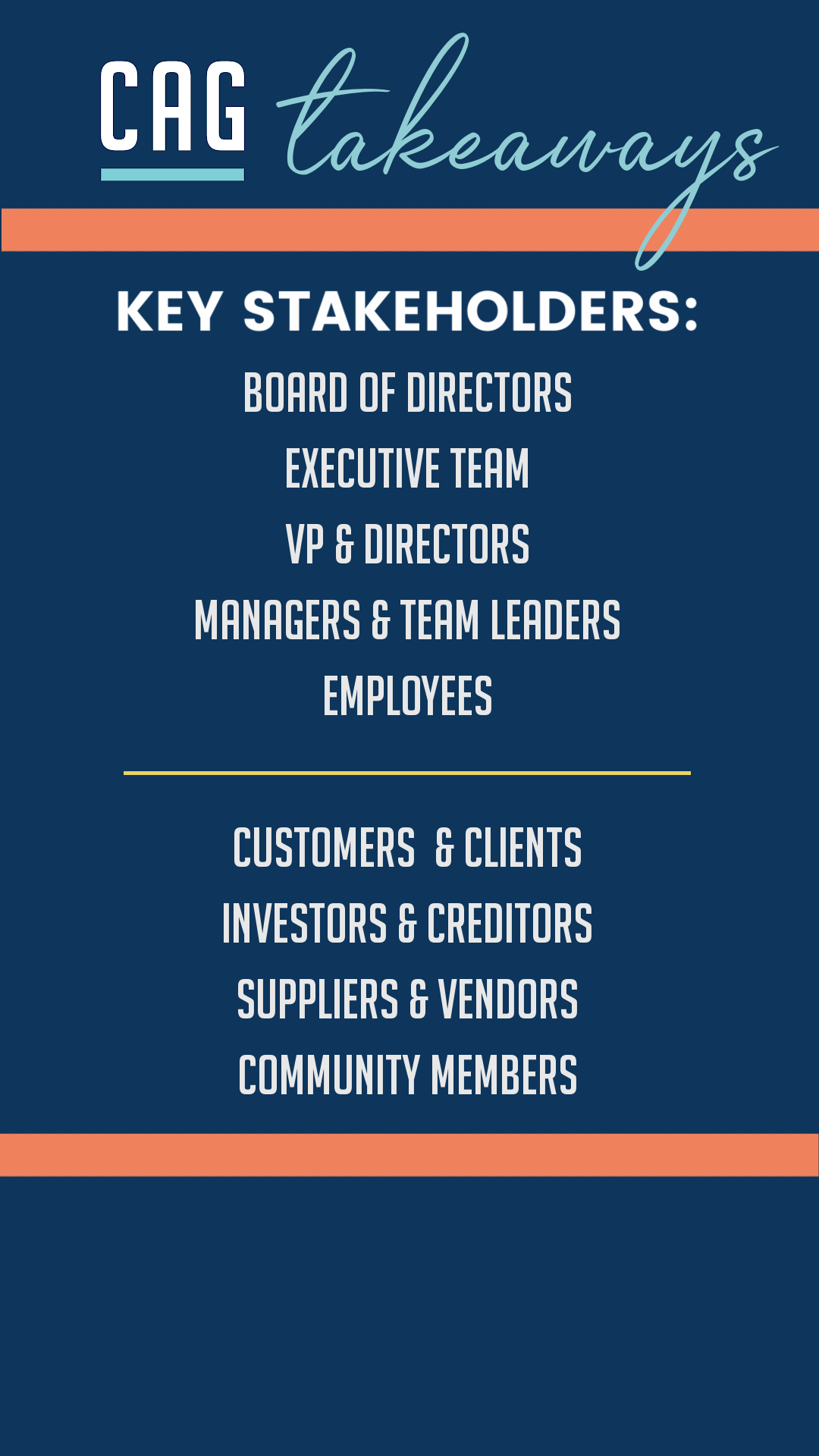
Who Should Be Involved in Strategic Planning?
After you’ve learned more about strategic planning and whether you need a strategic plan of your own, you might start to wonder about how you’ll create your first plan and who should be involved in strategic planning at your organization or small business.
And the answer to that question is…it depends.
Most notably, it depends on how your organization is operated (small business or non-profit entity) and how extensive you’d like your process to be.
Fundamentally, your first choice comes down to key stakeholders—determining who they are as it relates to your strategic planning process and how you’ll include them.
WHAT IS A KEY STAKEHOLDER?
First, let’s talk about what a key stakeholder is. Wikipedia defines a stakeholder (from a business standpoint) as:
“a member of ‘groups without whose support the organization would cease to exist’.”
This definition comes from the first known use of the term back in 1963 when it was included on an internal memorandum at the Stanford Research Institute, and more recent use dates back to the 1980s when the term finally gained wide acceptance in business parlance and in theories related to strategic management, corporate governance, the purpose of business, and corporate social responsibility (CSR) programs.
They also provided several examples of company stakeholders, including some ideas as broad as government entities and regulatory bodies. However, for the sake of our definitions, I’m going to group them simply into two (2) main categories most non-profit organizations and small businesses are likely to encounter—internal and external key stakeholders.
Most likely, these are the groups who should be involved in strategic planning in your organization and I’ll explain why.

INTERNAL KEY STAKEHOLDERS
Internal stakeholders are those directly involved with running the business or non-profit organization and are generally internal-facing members of the system. These typically include the following organizational groups:
- Board of Directors (or advisors)
- Executives
- Vice-Presidents and Directors
- Managers and Team Leaders
- Employees
They are the group that “makes the cheese” and sets the vision, mission, strategies, objectives and tactical goals for the organization and works to execute those goals on a regular basis.
Not all members of this group are necessarily compensated by the organization, but their investment in the outcomes the organization produces are usually far higher than the second group of external stakeholders.
So who should be involved with strategic planning from the internal stakeholder group? Let’s dive into each of these so you can best decide for your own situation.

? BOARD OF DIRECTORS & ADVISORS
This group should be involved if they will be held directly accountable for the outcomes of the organization or entity. This is particularly important for non-profit organizations, but may not be as critical for small businesses. Startups typically have a a small board of directors, and may also have an advisory group. Those stakeholders may be easier to involve in a less formal way like personal interviews, surveys or other direct communications if their feedback or expertise is valuable to the strategic planning process.
? EXECUTIVES
The organization’s executives should be heavily involved with the strategic planning process. There are likely no other members of the internal team who would have more at stake than this group when it comes to ensuring the strategic direction of the organization matches its mission, vision and other business goals. They should also be heavily involved in designing the strategic planning process and selecting any external partners or facilitators. They will also implement the outcomes of the process.
? VP & DIRECTOR LEVEL
Typically some members of the vice-presidential and director level are involved if they manage key components of the strategy that’s being set for the organization. It may not be practical to have every member at this level involved if the organization is larger, but smaller organizations tend to have the bandwidth for this group. They will implement the outcomes of the strategic plan at the direction of their executive team.
? MANAGERS & TEAM LEADS
Managers and team leaders might be best to involve in a small-group format or with surveys or team interviews. Generally speaking their ideas and feedback are collected and discussed during the strategic planning retreat so they can be incorporated into the larger goals, strategies, objectives and tactics. They will facilitate the completion of related work identified during the strategic planning process.
? EMPLOYEES
Employees are best involved in the strategic planning process by way of surveys and interviews. Typically there are far too many employees in large organizations to have them at the table for any type of strategic planning retreat, and they also often lack the real power to force the organization to consider any specific strategy. However, when sentiment is grouped in numbers, the power of employees can be more directly felt and implemented. So their feedback is critical to include, but you want to be thoughtful about how you do it.
EXTERNAL STAKEHOLDERS
External stakeholders are those who might be impacted by your brand, organization or small business, but they may or may not have a ton of direct influence on how you set your strategy. These include groups such as:
- Customers and Clients
- Investors and Lenders (or Creditors)
- Suppliers and Vendors
- Community Members
? CUSTOMERS & CLIENTS
Customers should have a seat at the table if they’ll be directly impacted about how your organization approaches its strategic direction. Perhaps you’ll have a customer or client review board. Or, maybe you’ll send your best customers a survey about improvements you’re considering. They might also sound off on new product lines you want to try. You’ll want to think of the best way to try and uncover the most honest sentiment from this group, and collect a sample that’s large enough to interpret the results in a meaningful way to see trends.
? INVESTORS & CREDITORS
This group will want to be more involved if their own money is on the line. This is particularly true for investors. Sometimes investors will help protect their investment by requiring a seat on the board, or to be notified about significant movement within the organization. Creditors or lenders may not have any say unless you’re defaulting on a loan or contract of some sort. This group is probably the most situational.
? SUPPLIERS & VENDORS
Suppliers, vendors and professional service providers may be curious about your strategic direction and simply want an opportunity to contribute if their specialization or offering might make a difference in your considerations. For example, a supplier might want to know about new packaging you’re considering, or new fulfillment options. Your accountant and legal team might want to know about a new business unit you’re starting and the implications of those choices.
? COMMUNITY MEMBERS
Finally, if community members are impacted by your organization’s work and direction, getting their feedback can prove invaluable. Some organizations do work in the community, or have an enormous impact on their neighborhoods and the families they serve. Not only will getting their feedback help outcomes, it will likely prevent unrest. It’s best to include them all along the way.
This can also be true for small businesses and brands. Your community members might be those who follow you online, but aren’t necessarily customers. Oftentimes this group is much larger and may have many thoughts (so many thoughts) about what you say and do. Why not give them a place to sound off? Proceed with caution here based on your experience with your online communities. ?
By now you should have a pretty good idea about who should be involved in your strategic planning process. But, if you still need help sorting through the details or asking about a specific group, feel free to drop us a line to chat. We’d be happy to share our thoughts with you…just like those community members!
Further Reading
Strategic Planning

Do you need a strategic plan?
Everything you could ever want to know about running a business is mostly online these days, so do you need a...
Marketing Strategy

Creating Your First Marketing Strategy – Free Template
Creating your first marketing strategy involves documenting the steps and ideas necessary to achieve your marketing...
Leadership

Courage & The Heart of Daring Leadership: Daring Leadership Series Part 2
Courage is the heart of daring leadership. So why is it so difficult to lead in a courageous way? In a...
Business Tools

Writing Your First Business Plan – Free Template
Writing your first business plan is one part knowledge, and another perseverance. Modern sentiment suggests that as an...
